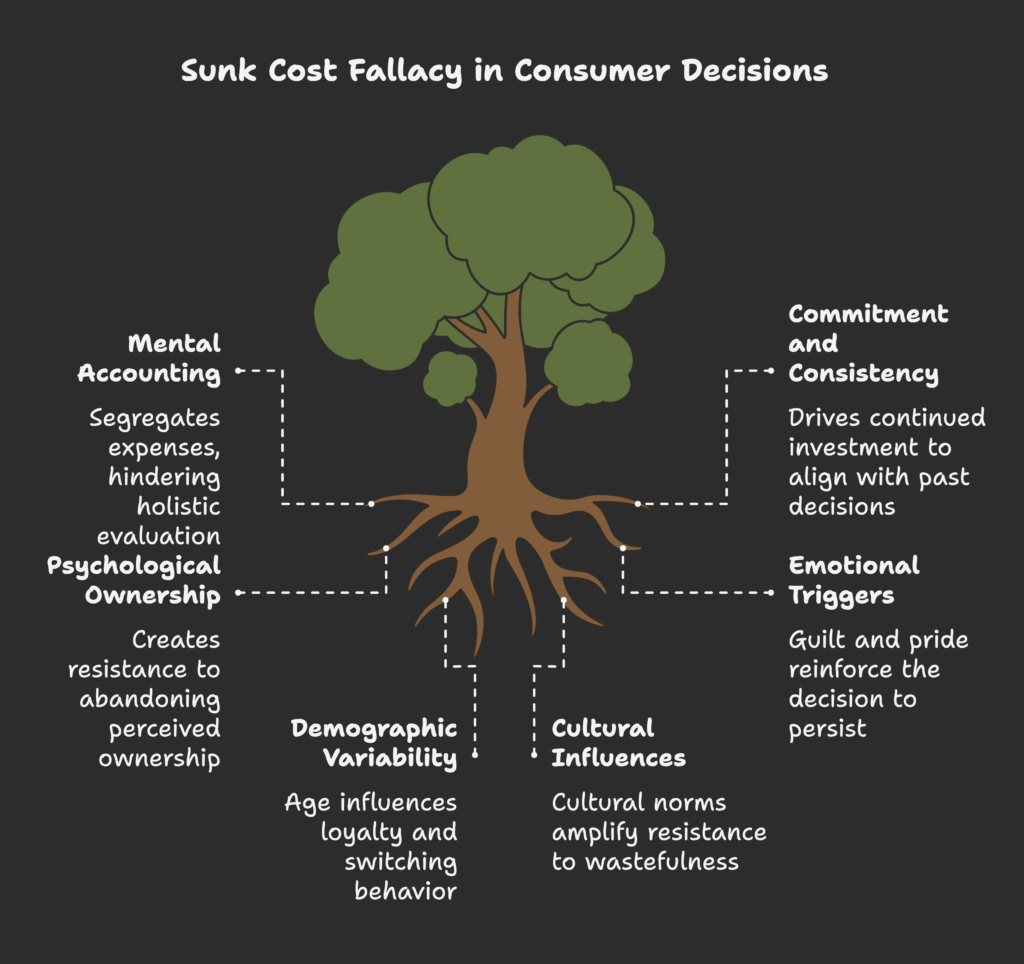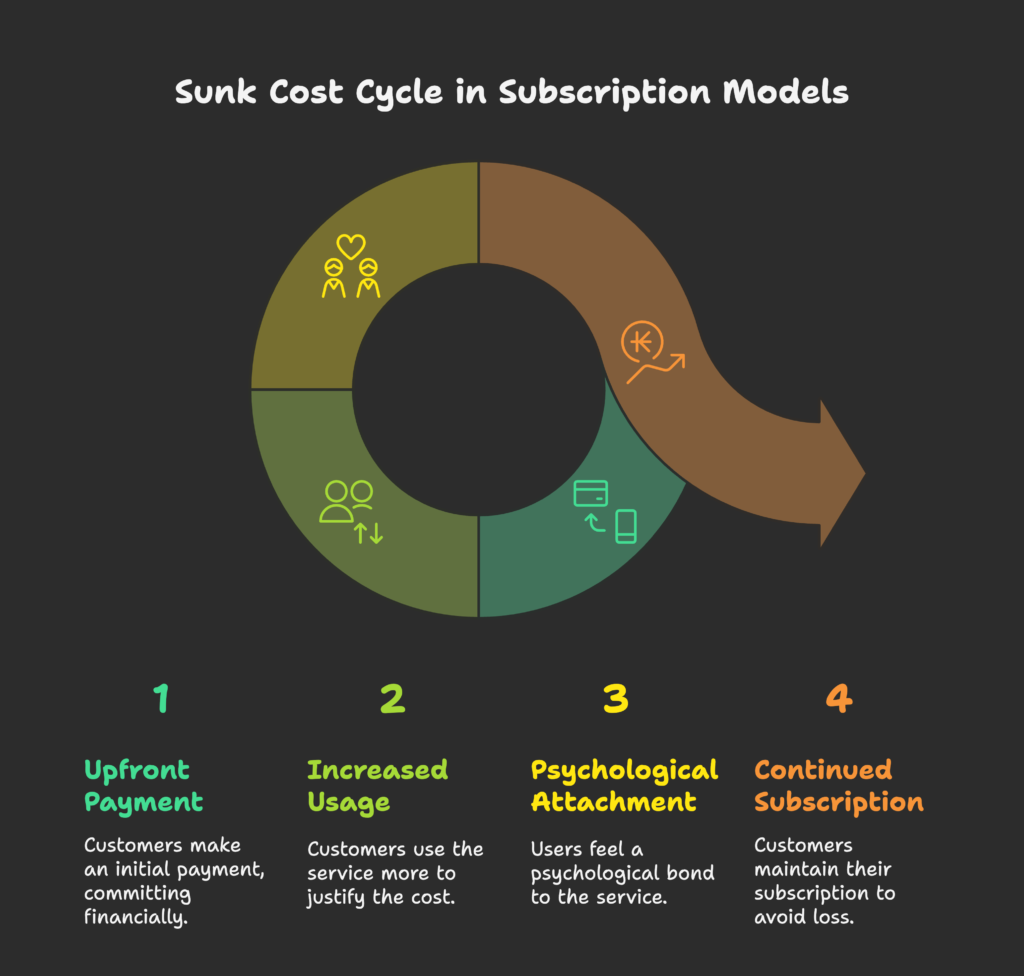Ever struggled to cancel a gym membership you never use – because you’ve already paid for it? Or continued playing a mobile game you dislike just because you spent money on it earlier? That’s the Sunk Cost Fallacy in action. In this article, you’ll learn why these past investments keep us hooked, how brands use them to encourage loyalty, and how to apply (or ethically manage) this bias in your business. Ready to see how “money already spent” drives customer decisions? Let’s jump in!
In this section: We’ll define the Sunk Cost Fallacy, reveal its psychological underpinnings, and highlight its economic impact on companies. You’ll see why rationally, past costs shouldn’t matter, yet they do – and how that shapes customer retention and brand loyalty.
Conceptual Framework and Definition
The Sunk Cost Fallacy describes our tendency to stick with an unprofitable or unfulfilling course of action simply because we’ve already invested time, money, or energy. Logically, past costs shouldn’t influence present decisions: they’re non-recoverable. But in *behavioral economics*, we consistently see people factor in these irretrievable expenses. This concept originated with analyses of irrational financial choices and has expanded to marketing and retention strategies. The difference between *rational* and *sunk cost-influenced* decision-making is that the latter is driven by the emotional weight of “I’ve come this far, so I can’t quit now.”
Psychological Foundations
Our minds don’t like inconsistency. *Cognitive dissonance* arises when we realize we’re paying for something we’re not using or continuing a project we dislike. We rationalize staying to avoid feeling wasteful. *Loss aversion*, a principle in *prospect theory*, further explains why giving up on an investment can feel like a guaranteed loss. Emotions often triumph over rational cost-benefit analysis when it comes to incomplete or underutilized purchases.
Economic Significance in Customer Relationships
From a business perspective, the Sunk Cost Fallacy can be harnessed to enhance retention. For instance, a user who prepaid for a year-long subscription might remain a customer even if they only use the service occasionally – simply to avoid feeling their money was wasted. Studies show this bias can significantly impact *customer lifetime value*, as people keep paying or staying rather than “lose” earlier investments. Over time, strategic exploitation of the Sunk Cost Fallacy can boost overall brand revenue and reduce churn.
Now that we know what the Sunk Cost Fallacy is, let’s explore the deeper psychological drivers in consumer behavior – from mental accounting to the emotional push to “not waste” previous investments.
The Psychology of Sunk Costs in Consumer Behavior
In this section: We’ll discuss how the human brain organizes decisions, looks for justifications, and clings to prior investments. We’ll also see how emotional triggers like guilt and pride shape these behaviors.

Cognitive Mechanisms
- Mental Accounting: We track expenses in separate “accounts” (e.g., “gym membership,” “online course”) rather than evaluating them in a holistic way. Once money is allocated, we feel compelled to “make it count.”
- Commitment and Consistency: We like our actions to align with previous ones. If we declared “This subscription is worth it,” we might keep paying to stay consistent with that statement.
- Psychological Ownership: After paying, we feel the service/product is “ours,” and we resist letting it go because that would signal losing a part of ourselves.
Emotional Drivers
Emotions further cement the hold of sunk costs. *Guilt* creeps in if we waste resources, and *anticipated regret* warns us we’ll feel silly for “throwing money away.” On the flip side, *pride* can come from “sticking it out,” or “making the best of what we bought.” People can actually feel relief by continuing – the dissonance dissolves if they can prove the initial spending was justified.
Individual Differences in Susceptibility
- Demographics: Younger consumers might be more prone to switching, while older ones might exhibit stronger loyalty, though results vary widely.
- Personality: Risk-averse individuals or those with strong “finisher” mindsets often cling to prior investments more.
- Cultural Differences: Some cultures place high importance on not wasting resources, intensifying sunk cost behaviors.
Recognizing these factors helps you tailor how you present costs and benefits to diverse segments.
But how does this specifically play out in subscription models? Let’s see how entertainment, fitness, and software services draw on sunk cost reasoning to keep subscribers engaged.
Sunk Cost Applications in Subscription Models
In this section: We’ll examine real-world examples, from movie memberships to digital software, where an upfront fee or continuing subscription fosters loyalty via sunk cost effects.

Movie and Entertainment Subscriptions
- Alamo Drafthouse Cinema’s Season Pass: Customers pay monthly for unlimited movie access. Many attend more shows than they ordinarily would, ensuring they’re “getting their money’s worth.”
- Membership Models: Netflix or Hulu rely on a monthly fee that encourages consistent usage, since unsubscribing might feel like admitting wasted fees up till now.
- Revenue Increase: Studies show box office or streaming usage can jump by up to 12-35% when people have a sense of “I’ve already paid, so let’s do it.”
Fitness and Health Club Memberships
Many people sign up, pay monthly or annually, and rarely attend. Yet they maintain membership because quitting would highlight their “failed commitment,” causing guilt. Gyms often design deals that harness this effect, such as an upfront annual payment at a slight discount, encouraging members to keep paying or keep going to classes “to justify the cost.” Corporate wellness programs also rely on pre-paid sessions to boost attendance.
Software and Digital Subscriptions
- SaaS Pricing Strategies: Providers encourage annual payments with a discount. Once customers pay, they’re less likely to jump ship, even if usage dips mid-year.
- Freemium Upgrades: Upgrading to a paid tier invests users further, making them reluctant to cancel. This leap keeps them exploring additional features so they don’t “waste” the upgrade.
- In-App Purchases: Once you buy extras in a game, you’re psychologically attached, and unsubscribing or quitting feels like losing that “investment.”
We see subscription models gain from the Sunk Cost Fallacy. Now, let’s shift to loyalty programs, focusing on how paid vs. free membership structures drive that sense of “I must keep using this.”
Loyalty Programs and Sunk Cost Psychology
In this section: We’ll explore how loyalty programs exploit or reduce sunk costs, how paying for a membership vs. getting one free changes user motivation, and how points-based systems keep us from dropping out.
Paid vs. Free Loyalty Programs
Some brands charge for membership, believing that paying up front intensifies loyalty and usage. Research by *Ashley et al. (2015)* found that customers in paid programs show *higher commitment* than in free ones. Why? They’ve already “invested,” so they want to recoup that cost. If the membership is free, they feel fewer regrets dropping out. Apple’s iCloud, for example, has paid storage tiers that many hold onto for years, reluctant to lose “paid privileges.”
Point Accumulation Systems
- Preventing Point Expiration: The idea of losing unredeemed points triggers sunk cost thinking: “I earned them, so I should keep buying to use them effectively.”
- Spikes in Member Activity: People rush to redeem just before expiration, showing how the threat of losing “invested points” drives last-minute sales or engagement.
By designing the point system so that *just a bit more* spending hits a new reward tier, you can nudge members to continue purchasing to avoid seeing their prior accumulation go to waste.
Hybrid and Tiered Program Structures
Loyalty systems that offer both free and paid options can drive incremental commitment. Once a user invests in the “premium tier,” their psychological cost for leaving is higher. They might see it as *throwing away* their entire membership fee if they stop. By combining free entry with an enticing paid upgrade, you let them step deeper into the sunk cost effect. For instance, “Victory Rewards” might be free, but the “Season Pass” costs a small annual fee, hooking them further.
Ready to harness these insights? Next, we’ll check out how to systematically build them into your marketing, from pricing to messaging, along with some do’s and don’ts.
Strategic Implementation for Business
In this section: We’ll outline how to design pricing, communications, and commitment devices that gently push customers to remain engaged due to their prior investments. You’ll see how to keep them satisfied rather than resentful.
Pricing Structure Optimization
- Two-Part Tariffs: One model is a base membership fee plus pay-per-use. Example: Costco’s membership plus product costs. The membership’s cost fosters loyalty, as they want to justify it.
- Fixed Fee vs. Pay-Per-Use: For certain categories, a big upfront fee that fosters continued usage might be better. Some markets, though, prefer pay-per-use. Testing is crucial to find your sweet spot.
- Investment Goods (U-Shaped Curve): For goods that require ongoing usage (like software licenses), charging too little reduces the feeling of investment, while charging too much may repel sign-ups. Aim for a balanced approach that triggers enough “I’ve invested” thought without scaring them away initially.
Communication and Framing Strategies
*Frame messages* that highlight the existing investment. For instance:
- Usage Reminders: “You’ve already saved $X by being a member—keep going!” This references the user’s prior investment and potential savings so far.
- Highlight Past Gains: “Over 6 months, you’ve used our service for 45 hours—don’t let that progress go to waste!” People hate losing achievements.
- Value Reinforcement: Periodically show them how the subscription or membership is paying off, so they remember their decision was wise.
Subtly referencing sunk costs can gently push them to stay, while overtly pressuring them can be off-putting. A balanced, helpful tone is best.
Commitment Device Implementation
- Upfront Fees as Self-Control Tools: Some customers intentionally pick all-year membership to force themselves to commit. This fosters a synergy with their personal goals (e.g., daily gym visits).
- Balancing Flexibility & Commitment: If it’s too rigid (no cancellations allowed), users might resent it. If too flexible (cancel anytime), it loses the psychological “lock-in.” Middle ground: short free trial + discounted annual plan.
- Align with Long-Term Goals: Make sure the structure helps them meet real aspirations, not just pay. That ensures loyalty and positivity, not buyer’s remorse.
Implementing is only half the puzzle. Next, let’s see how to measure if these strategies are truly leading to better retention and more revenue, plus user satisfaction.
Measurement and Analysis of Sunk Cost Effects
In this section: We’ll talk about key indicators to watch (like usage frequency after an upfront payment), how to run experiments to see if your approach works, and how to gauge the overall economic impact on your business.
Behavioral Indicators
- Consumption Patterns: Check if usage spikes or remains steady after an upfront membership fee or subscription renewal. Are they actively using the product more after paying a lump sum?
- Retention Rates: Compare customers on monthly vs. annual plans. The latter might show stronger loyalty due to sunk costs.
- User Reactions to Price Adjustments: If you raise fees, do people drop out or stay, rationalizing “I’ve already invested so much”?
Experimental Research Designs
- A/B Tests: Offer two pricing models (one with a bigger upfront cost, one with monthly fees) and measure retention or usage differences.
- Field Experiments: For example, test how free trial durations impact eventual conversion, seeing if a quick “pay now” approach fosters bigger sunk cost effects.
- Longitudinal Studies: Follow users over months to confirm how their initial investment shapes ongoing loyalty—especially relevant for software or fitness clubs.
Economic Impact Assessment
Ultimately, you want to see if your approach yields *higher revenues, lower churn*, and positive brand equity. If membership sales go up but user satisfaction drops, that’s not sustainable. A cost-benefit analysis might measure:
- Revenue Uplift: Gains from added sign-ups or from customers who’d normally leave but stay due to sunk cost feelings.
- Support Costs: Do you need more support staff for semi-active customers who remain just to avoid feeling they wasted money?
- Long-Term Growth: Sunk cost loyalty can be ephemeral if not paired with real product value. Keep an eye on brand reputation metrics.
All sectors can leverage this phenomenon, from retail to finance. Let’s check out some highlights in different industries to see how it’s done well—and what pitfalls to avoid.
Industry-Specific Applications and Case Studies
In this section: We’ll explore how sunk costs manifest in retail, financial services, gaming, and how each domain reaps benefits by encouraging continued user participation.
Retail and E-commerce
- Premium Memberships: Amazon Prime’s annual fee ensures many remain loyal, making frequent small orders to “justify” the shipping benefits.
- VIP Tiers: Some fashion retailers have paid loyalty tiers. Once you shell out for the membership, you aim to shop more to maximize your return.
- Advance Purchase Commitments: Prepaid bundles or “meal kits” – people often keep them going out of guilt if they skip. The fear of “wasting food” or “unused credit” fosters consistent usage.
Financial Services
- Banking Relationship Depth: If you pay monthly fees for certain privileges, you might stick with the same bank rather than switch and “lose” the fees you’ve invested, even if a competitor is cheaper.
- Insurance Premiums: People who pay for additional riders or coverage sometimes remain locked in, feeling “I’ve already invested so much in this coverage.”
- Investments: Holding onto underperforming stocks or funds because you “already spent so much time/money” is a classic example of the Sunk Cost Fallacy in personal finance.
Gaming and Entertainment
Gaming is a big sphere for the Sunk Cost Fallacy. Many free-to-play games rely on micropayments that lead players to keep playing just to validate past spending. Seasonal passes or “battle pass” structures also create cyclical “I should finish this pass to make my money worth it.” The sense of lost progress (and thus lost money) is a potent nudge to stay engaged. E-sports communities further heighten this by offering exclusive skins or expansions that feed the cycle of “If I give up now, I lose everything I’ve built up.”
Of course, there are ethical dimensions to all this. Next, we’ll delve into potential manipulations, fairness to customers, and what to watch out for so you maintain trust, not resentment.
Ethical Considerations and Limitations
In this section: We’ll discuss the moral line between using sunk costs as a strategic impetus and exploiting consumer psychology. We’ll also examine cultural or socio-economic factors that might intensify or mitigate such influences.
Transparency and Consumer Welfare
- Clear Disclosures: If a membership auto-renews, inform your customers. People shouldn’t feel tricked into continuing out of confusion or hidden fees.
- Genuine Value: Provide legitimate benefits that reward continuous usage. Relying on guilt alone is manipulative and can spark backlash.
- Balance with Education: Encourage customers to reflect on usage. If they truly don’t need a service, they should feel comfortable canceling without stigma.
This fosters brand loyalty, ironically, by letting them step away if they must—rather than forcing them to rely on guilt alone.
Subscription Guilt Phenomenon
People often feel a pang of guilt every month if they’re not fully using their membership. Some brands may deepen that guilt to keep them from canceling. But too much guilt eventually turns to frustration and brand negativity. Good companies address this by offering usage tips, product improvements, or short breaks that keep the relationship healthy. Tactics that intentionally weigh customers down with guilt risk reputational harm in the long run.
Regulatory and Policy Implications
- Consumer Protection: Some regions require easy cancellations or disclaimers about subscription renewals. Overly complex processes can be seen as exploitative.
- Ethical Marketing Norms: As public awareness of psychological biases grows, self-regulatory bodies push for more upfront clarity in contract terms, renewal periods, or cancellation rules.
Staying ahead of these regulatory standards means shaping a business model that ensures your customers are satisfied, not cornered by sunk cost illusions.
But the world moves fast. Let’s talk about future directions—AI and new tech might revolutionize how companies adapt membership fees or nudge usage to maintain retention while respecting user well-being.
Future Trends and Innovations
In this section: We’ll look at AI’s role in personalizing sunk cost appeals, the possibility of using VR or blockchain to intensify or shift user perceptions of “invested” resources, and the next wave of creative subscription or membership models.
Technological Developments
- AI and Predictive Analytics: Systems that detect diminishing usage and intervene with well-timed “We see you haven’t used us lately—don’t let your membership go to waste!” messages, potentially offering tips or personalized modules.
- Mobile App Innovations: More dynamic, push-notifications reminding users of leftover balances or expiring freebies. This interplay triggers the “I’ve paid, better use it!” effect on the go.
- Blockchain and Token Economics: Some loyalty or membership tokens can add a new spin: since tokens can hold real value, giving them up or ignoring them might intensify the sunk cost effect further.
Emerging Business Models
We’re also seeing *community-based ownership* or membership structures: think co-ops or partial brand ownership through NFT or share models. That sense of “I’m literally a co-owner” can deeply anchor loyalty. Similarly, subscription boxes are blending physical and digital experiences, making it even harder for a subscriber to say “not worth it” if they feel personally invested in a vibrant community or lifestyle identity.
Cross-Disciplinary Innovations
As more academic fields (psychology, neuromarketing, etc.) combine forces, advanced *behavioral design* emerges. This merges sunk cost strategies with nudges like commitment devices and loss aversion prompts. The future likely features personalization that identifies your unique sunk cost threshold and tailors messaging or product structures accordingly. While powerful, it demands care to remain beneficial for both brand and user.
Now we’ll wrap up with a practical, step-by-step guide to adopting the Sunk Cost Fallacy effectively—without burning your users or your reputation.
Conclusion and Practical Implementation Guide
In this section: We’ll summarize the top strategies for harnessing the Sunk Cost Fallacy in an ethical, customer-friendly way. You’ll learn how to roll out these principles, test them, and refine for long-term success.
Key Principles Summary
- Highlight Past Investments: Gently remind customers of what they’ve already spent or achieved so they prefer continuing rather than “losing” prior gains.
- Structure Pricing/Programs to Encourage Ongoing Engagement: Upfront fees and membership tiers can push users to keep usage high.
- Ensure Real Value: Don’t rely purely on guilt. Provide features, content, or achievements that reward them for staying, so they feel validated.
- Ethical Boundaries: Remain transparent, keep cancellation options clear, and avoid manipulative tactics that breed resentment.
Implementation Roadmap
- Assess Current Offerings: Identify where sunk cost logic might already be playing a role (e.g., subscription renewal friction) and see if you can optimize it.
- Phased Rollout: Start by tweaking one service or membership plan with a new payment structure or usage-tracking messages. Monitor the results.
- A/B Testing: Compare outcomes between standard vs. sunk-cost-framed communications or programs. Confirm retention lifts are real.
- Refine and Expand: Use analytics and user feedback to balance emotional impetus with genuine service improvements. Then scale across your entire suite of products or services.
Future Research Directions
- Neuro-Behavioral Studies: Brain imaging to detail exactly how and when sunk cost triggers loyalty or brand frustration.
- Cross-Cultural Exploration: Deeper insight on how various societies interpret “waste” vs. “commitment.”
- Long-Term Brand Impact: Explore how extended reliance on sunk cost strategies shapes brand trust, net promoter scores, and user communities.
Ultimately, a well-managed use of sunk cost can align customers’ immediate motivations with your brand’s growth, forging loyalty that lasts beyond a single subscription cycle.
Small Note: If you’re a Shopify merchant aiming to boost retention through savvy subscription design or membership programs, check out the Growth Suite app. It helps integrate sunk cost strategies ethically, track them with real-time data, and keep your store’s customers engaged for the long haul.
References
- Zhang, X., Iyer, G., Xu, X., & Chong, J. K. (2023). Sunk Cost Effect, Self-control, and Contract Design. University of California at Berkeley. Link
- Loyalty Reward Co. (2023). Loyalty Psychology Series: Sunk Cost Effect. Link
- The Decision Lab. (2023). The Sunk Cost Fallacy. Link
- DBTA Agency. (2023). Falacia del costo hundido — Sunk cost fallacy. Link
- Zhang, X., Iyer, G., Xu, X., & Chong, J. K. (2021). Sunk Cost Fallacy, Self-control, and Contract Design. Semantic Scholar. Link
- Adogy. (2025). Falacia del costo hundido. Link
- Vallejo Chávez, L. M., Miranda Salazar, M. F., de León Nicaretta, F. M., & Ureña Torres, V. R. (2024). Cognitive Bias Sunk Cost in Marketing. Cognition Commerce. Link
- Library Fiveable. (2025). Sunk cost fallacy – (Intro to Marketing) – Vocab, Definition, Explanations. Link
- Semantic Scholar. (2020). The Impact of Subscription Programs on Customer Purchases. Link
- Semantic Scholar. (n.d.). The Success of the Freemium Business Model. How Riot Games flourishes with a free to play game. Link




